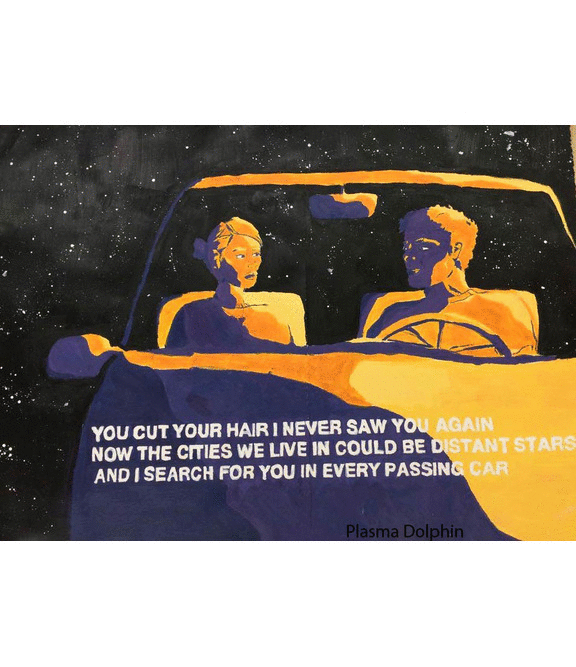by Rachel Davies
In 2013 I was in grade ten, bored in the last stretch of school until summer, and then I discovered zines – specifically, self-published work from my favourite comic artist, Dash Shaw. Since I still had this view of artists as monumental creatures that I could never match up to, I initially viewed zines as far out of my league — I began collecting them, but I felt far from creatively adequate enough to make them. It was through Rookie Mag that I realized that zines were meant to be DIY and that teens (like me) were capable of making noteworthy work.
At first I started to make mini-zines with printed-out screenshots from the late ‘90s animated TV show, Hey Arnold! and quotes from my favourite books. Despite being quiet in the hallways at school, I was loud on social media and this allowed for me to make quite a few friends online who I felt closer too than the ones I had in my hometown. Because we were all sharing photos and blurbs of our creative work on social media, it only seemed natural to collect these works in one online space.
It was then that I founded Pop Culture Puke, a website and zine for teenage girls to share their emotions regarding absolutely anything. While I no longer edit the website (it was taken over by Molly Gorelick and Kathryn Schultz) PCP still has the same mission – to be a space for teen girls to obsess over all their obsessions, and especially the ones that they are belittled for IRL. Fangirl culture, the possibility of dropping out of college, and Lou Reed’s death are just a sample of our chosen topics. Seeing these obsessions celebrated by other teens has validated these experiences and made public creativity more intriguing. From my understanding, this is why most teen zines operate in groups now — in the online realm, a curiosity for creativity has bonding power.
Countless teen zines with various focuses have cropped up recently, each of them with very personal DIY approaches. The accessibility and user friendliness of digital zine-making programs allows teens to focus on what’s really important – their own stories. Here’s a selection of my favorite zinemakers currently sharing their stories online and in print.
Andy Coronado
Andy is a 16-year-old writer from New Jersey. They’ve gained a following of over 8,000 people online. Besides self-started zine projects and script writing, their work has been featured in Cry Baby Zine, Written Citizen, and Radigirl Mag. Andy’s work touches on themes of capitalism, selfies, and queerness – and Andy’s work helps teens approach these subjects through an open and unintimidating lens.
Plasma Dolphin
When I first discovered Plasma Dolphin, edited by Waterloo, Ontario-based 18-year-olds Sonja Katanic and Emma Cohen, I was flabbergasted. It’s an online zine with ample personal charm— the girls custom create all of the headers. Their themes are broad and open to interpretation – for example, Issue 8’s theme was Worlds Collide, and Issue 7’s was The Moment Before, and many issues contain interactive work for the “For U 2 Do” section, including printable how-to’s. Reading Emma and Sonja’s work feels like witnessing the beginning of a friendship.
Navya Dasari
Navya is an 18-year-old illustrator from Arizona who views creativity as “being dissatisfied with what is dishonest and tired, and letting your passion direct you to something clear and new.” This surely aligns with what first drew me to Dasari’s work — her work centers Asian, African-American and Middle Eastern girls, and stands out from a world of illustration that can be very white-centric. While Navya sees art as a hobby, rather than a career choice, she shares her work in collective zines like Pop Culture Puke because she takes pleasure from seeing how zine editors interpret her work and place it in context with others.
Charlotte Southall
19-year-old Birmingham, UK-based artist Charlotte Southall
has been featured in the zines Herpothesis, Pop Culture Puke, and Screen Queens. When I spoke to Charlotte, she said that she felt she could never be taken seriously in the real world because of her age, but that zines helped her overcome this and her age has only made her feel empowered within the community. Charlotte’s skilled, imaginative portraiture and wild use of colour combats the idea that teens are self-involved for caring about how they look.
Sula Collective
Sula Collective is a zine project by and for people of color. When asked to describe the outlook behind the zine, co-founder Sophia Yuet See quotes contributor Diana Bamimeke— it’s “a magazine specifically for people of colour, a safe space in which to share our frustrations and hopes through the most creative mediums.” Sula features a variety of work including personal stories, like Diana Bamimeke’s piece about missing Nigeria, and Kassandra Piñero’s article “HAIR n HOUSING”, about moving back to a predominantly white town and growing out her shaved head. When it comes to dream creatives to feature in the zine, Kassandra chooses Junot Diaz and Sophia would 100% choose Solange.
Clara Talajic
While collective zine making is wildly popular in today’s teen zine community, 18-year-old Clara Talajic tends to work solo. She roams the halls of her Ottawa high school during the days and at nights experiments with her hand drawn style and occasionally experiments with web art, like GIFs. She feels that her current work – which includes three dimensional sculptural projects – is very much in her comfort zone.
Herpothesis
While most zines focus primarily on creativity, pinned together by monthly themes, Herpothesisis is quite different. Founded by then-teen Alex Hansen, Herpothesis is a zine dedicated to exploring and widening female involvement in STEM (science, technology, engineering and math). With articles dedicated to wearable tech, volcanology, and interviews with women excelling in the field, Herpothesis quickly makes STEM fascinating – even to those of us who didn’t love science in the classroom.

